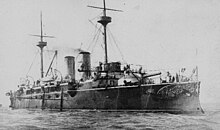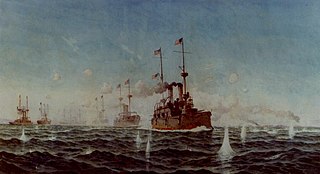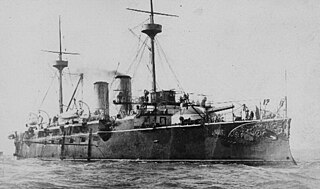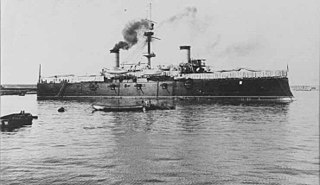Contents
- Unprotected cruisers
- Protected cruisers
- Armoured cruisers
- Light and scout cruisers
- Heavy cruisers
- Notes







The Battle of Manila Bay, also known as the Battle of Cavite, took place on 1 May 1898, during the Spanish–American War. The American Asiatic Squadron under Commodore George Dewey engaged and destroyed the Spanish Pacific Squadron under Contraalmirante Patricio Montojo. The battle took place in Manila Bay in the Philippines, and was the first major engagement of the Spanish–American War. The battle was one of the most decisive naval battles in history and marked the end of the Spanish colonial period in Philippine history.

The Battle of Santiago de Cuba was a decisive naval engagement that occurred on July 3, 1898 between an American fleet, led by William T. Sampson and Winfield Scott Schley, against a Spanish fleet led by Pascual Cervera y Topete, which occurred during the Spanish–American War. The significantly more powerful US Navy squadron, consisting of four battleships and two armored cruisers, decisively defeated an outgunned squadron of the Royal Spanish Navy, consisting of four armored cruisers and two destroyers. All of the Spanish ships were sunk for no American loss. The crushing defeat sealed the American victory in the Cuban theater of the war, ensuring the independence of Cuba from Spanish rule.

Admiral Pascual Cervera y Topete was a prominent Spanish naval officer with the rank of Almirante (admiral) who served in a number of high positions within the Spanish Navy and had fought in several wars during the 19th century. Having served in Morocco, the Philippines, and Cuba, he went on to be Spain's naval minister, chief of naval staff, naval attaché in London, the captain of several warships, and most notably, commander of the Cuba Squadron during the Spanish–American War. Although he believed that the Spanish Navy was suffering from multiple problems and that there was no chance for victory over the United States Navy, Cervera took command of the squadron and fought in a last stand during the Battle of Santiago de Cuba.

Reina Cristina was an Alfonso XII-class unprotected cruiser of the Spanish Navy built at the naval shipyard at Ferrol and launched 2 May 1887. Reina Cristina spent her early years in Spanish waters. In 1894 she was transferred to the Spanish Navy's Asiatic Squadron to deter any aggressive moves the German Empire might take against the Spanish-owned Caroline Islands in the Pacific. When Spain faced the "Tagalog Revolt" (1896–1897) – the Spanish name for the first two years of the Philippine Revolution – in the Philippine Islands, Reina Cristina was actively involved in the Spanish campaign to put down the revolt. In addition to patrolling Philippine waters to prevent the smuggling of contraband to the insurgents, she also supported Spanish Army actions against them at Cavite, Novaleta, and Binacayan, including the provision of naval gunfire support to Spanish troops ashore.

Reina Mercedes, was an Alfonso XII-class unprotected cruiser of the Spanish Navy.

Isla de Luzón was an Isla de Luzón-class protected cruiser of the Spanish Navy which fought in the Battle of Manila Bay.

Vizcaya was an Infanta Maria Teresa-class armored cruiser of the Spanish Navy that fought at the Battle of Santiago de Cuba during the Spanish–American War.

Almirante Oquendo, was an Infanta Maria Teresa-class armored cruiser of the Spanish Navy that fought at the Battle of Santiago de Cuba during the Spanish–American War.

Infanta María Teresa was the lead ship of her class of armoured cruiser constructed for the Spanish Navy. The ship fought at the Battle of Santiago de Cuba during the Spanish–American War.

Cristóbal Colón was a Giuseppe Garibaldi-class armored cruiser of the Spanish Navy that fought at the Battle of Santiago de Cuba during the Spanish–American War.
Plutón was a Furor-class destroyer of the Spanish Navy that fought at the Battle of Santiago de Cuba during the Spanish–American War.

Furor was a Furor-class destroyer of the Spanish Navy that fought at the Battle of Santiago de Cuba during the Spanish–American War.

The Velasco class of unprotected cruisers was a series of eight cruisers built during the 1880s for service with the Spanish Navy. They were named after Luis Vicente de Velasco.

Emperador Carlos V was an armored cruiser of the Spanish Navy which served in the Spanish fleet from 1898 to 1933. The money intended to build torpedo boats was used to build a 9,000-ton cruiser, deriving this cruiser from the British Blake class. Said cruiser stood out for its great autonomy, while it suffered from having little armor, mounting only during its first days of life 4 pieces of García Lomas of 100 mm.

The Infanta Maria Teresa class of three armored cruisers were built for the Spanish Navy between 1889 and 1893. All three were sunk in action against the United States Navy during the Battle of Santiago de Cuba in 1898.

The Alfonso XII class of unprotected cruisers was a series of three ships built during the 1880s for service with the Spanish Navy. They were named for a Spanish king and two Spanish queens.

USS Isla de Cuba was a Isla de Luzón-class protected cruiser of the United States Navy captured from the Spanish Navy during the Spanish–American War. Originally named Isla de Cuba for the Spanish colony of Cuba, the ship was ordered from the British shipbuilding company Sir W.G. Armstrong Mitchell & Company in January 1886 and laid down on 25 February 1886. The ship was launched on 11 December 1886 and completed in 1887. The vessel fought in the Rif War before being assigned to Spain's fleet in the Philippines. When the Spanish fleet in the Philippines was attacked by the United States Navy during the Battle of Manila Bay, Isla de Cuba was scuttled to prevent capture. However, the Americans raised the ship and commissioned her into the United States Navy in 1900 and assigned to the Asiatic Station, keeping the same name. In US service, the ship, rerated as a gunboat, was used to suppress the Philippine Revolution. The vessel was taken out of American service in 1904, becoming a school ship. In 1912, the US sold the ship to Venezuela which renamed her Mariscal Sucre. The ship was scrapped in 1940.

The Furor class was a type of destroyers of the Spanish Navy, similar to the units of the A class, or 27 knotters, of the British Royal Navy. Commissioned in 1896 by the then Minister of the Navy Admiral Beranger after the success of the design by Fernando Villaamil of the warship Destructor, which had given name to a whole typology of vessels.